
Tetratheca is a genus of around 50 to 60 species of shrubs endemic to Australia. It is classified in the botanical family Elaeocarpaceae, now known to encompass the family Tremandraceae, which the genus originally belonged to. It occurs throughout extratropical Australia, and has been recorded in every mainland state except the Northern Territory.
Chthonocephalus is a genus of annual herbs in the family Asteraceae. The genus is endemic to Australia, with species occurring in all mainland states.
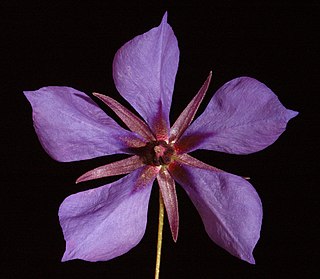
Platytheca is a genus of small shrubs in the family Elaeocarpaceae from the south-west of Western Australia. The genus was formally described by Joachim Steetz, his description published in Plantae Preissianae in 1845.
Hyalosperma is a genus of Australian flowering plants in the sunflower family.
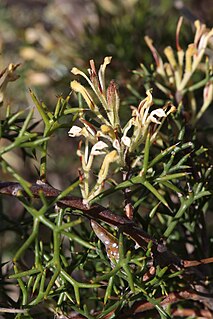
Hakea erinacea, commonly known as hedgehog or porcupine hakea, is a shrub in the family Proteaceae endemic to south-west Western Australia.
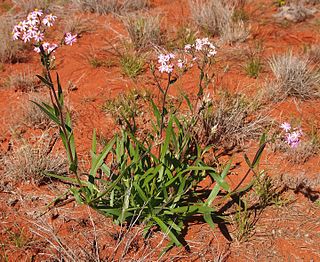
Schoenia is a genus of Australian plants in the pussy's-toes tribe within the daisy family.

Pogonolepis is a genus of Australian plants in the tribe Gnaphalieae (pussy's-toes) within the daisy family Asteraceae.

Tetratheca hirsuta, commonly known as black-eyed Susan, is a small shrub in the family Elaeocarpaceae. Endemic to the south-west of Western Australia, it is not related to other plants known as black-eyed Susan around the world.
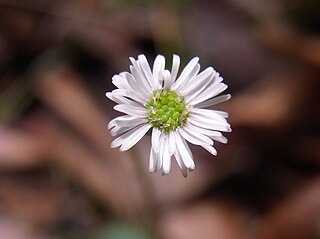
Lagenophora gracilis is a small plant in the daisy family, found in eastern Australia, and in tropical Asia. Common names include Slender Bottle-daisy and Slender Lagenophora. The habitat is the floor of Eucalyptus forests, often in moist situations.

Hakea aculeata, commonly known as the column hakea, is a vulnerable species of the family Proteaceae found in the Wheatbelt region of Western Australia. An unusual sculptural species with dense columns of prickly foliage and plentiful clusters of strongly scented blooms in spring.

Hakea costata, commonly known as the ribbed hakea, is a shrub in the family Proteaceae native to Western Australia. A multi-stemmed small shrub producing attractive pink or white brush-like blooms rich in nectar from July to October.
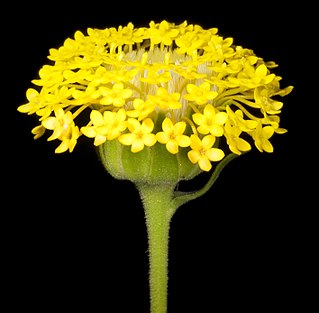
Podotheca chrysantha is a small herb in the family Asteraceae endemic to Western Australia. It grows from 0.2 to 0.5 m high, and has yellow flowers which are seen from August to December. It grows in sand over limestone or laterite on limestone ridges and in wet depressions.
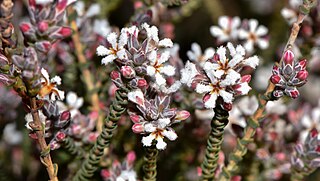
Leucopogon sprengelioides is an erect shrub in the family Ericaceae found in Western Australia, where it grows on granite outcrops and hill, ridges and breakaways and on coastal limestone. It grows to a height of 0.2 - 0.8 m and its white flowers may be seen from March to April or July to November.

Leucopogon pulchellus, commonly known as coast beard-heath, is a shrub in the family Ericaceae, native to the south west of Western Australia. It grows to heights between 15 cm and 1.5 m, generally on lateritic or granitic soils, and its white flowers may be seen from June or November or from January to February.

Tetratheca glandulosa is a spreading shrub in the family Elaeocarpaceae. It is endemic to New South Wales.
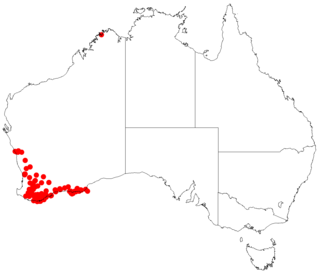
Asteridea nivea is a herb in the Asteraceae family, which is endemic to Western Australia. It was first described in 1845 by Joachim Steetz as Chrysodiscus niveus. In 1980, G. Kroner assigned it to the genus, Asteridea, giving it the name Asteridea nivea. It is a perennial herb, sometimes erect, sometimes low-spreading which grows on sandy soils often over granite, laterite, or limestone to heights from 10 cm to 60 cm, in rock crevices, on ridges and coastal cliffs. Its white to white-pink flowers may seen from April to May or August to September in Beard's South-West Province, that is, the IBRA regions of Avon Wheatbelt, Esperance Plains, Geraldton Sandplains, Jarrah Forest, Mallee, and Warren.

Argentipallium niveum is a species of plant within the genus, Argentipallium, in the daisy family (Asteraceae). It is endemic to Western Australia.

Comesperma drummondii, commonly known as Drummond's milkwort, is a slender herb in the family Polygalaceae. It is a perennial herb growing to between 20 cm and 1.2 m high, on sandy and gravelly soils Its pink-blue-purple flowers may be seen from August to November.

Pogonolepis stricta is a species of daisy (Asteraceae), which is endemic to Western Australia. It was first described by Joachim Steetz in 1845.

Pterochaeta is a monotypic plant genus in the Asteraceae family, endemic to Western Australia. It was first described in 1845 by Joachim Steetz and its only species is Pterochaeta paniculata.
















